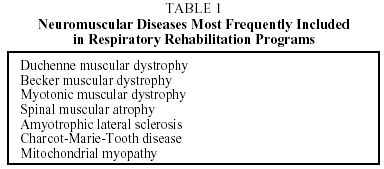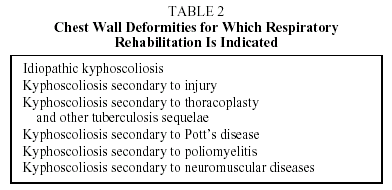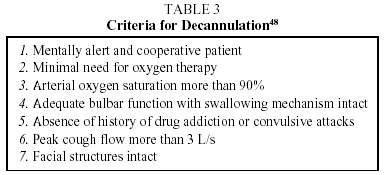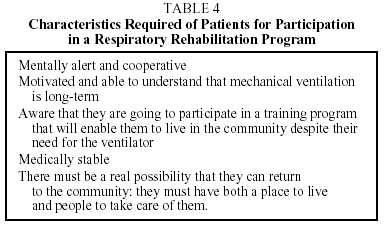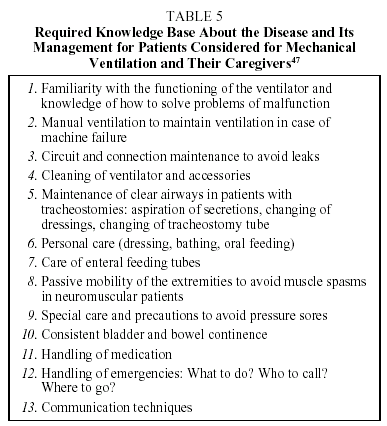Introduction
Respiratory failure can occur in a great number of diseases, only some of which are directly related to the lungs or airways. Respiratory rehabilitation initially focused on patients with chronic obstructive pulmonary disease (COPD), but was later applied to patients with limited functional capacity as a result of chronic respiratory insufficiency not associated with airway obstruction. In these patients, lung function is impaired by processes basically affecting the respiratory pump, such as neuromuscular or chest wall diseases. In this chapter we will discuss respiratory rehabilitation applied to such diseases.
Definition of Respiratory Rehabilitation
Respiratory rehabilitation is defined as a process by which health professionals and other specialists, together with patients and their families, work as a team to achieve and maintain improvement in respiratory patients' functional capacity and health-related quality of life (HRQL).1 Respiratory rehabilitation covers a wide range of multidisciplinary services designed to manage patients with respiratory problems and, in addition, to cover other needs stemming from the disease, such as muscle changes, and emotional or social problems.
Neuromuscular diseases and chest wall deformities are pathological conditions presenting specific signs and symptoms that are not limited to associated respiratory impairment. These conditions lead to a deterioration of normal function. As respiratory rehabilitation is used in a wide variety of diseases, treatment must be individualized and patients accurately classified with respect to impairments, disabilities, and handicaps. The World Health Organization2 has defined these terms as follows:
- Impairment is the loss or alteration of normal anatomical structure, physiology, or psychological function.
- Disability is the restriction, due to impairment, of the ability to perform different activities in a manner considered normal for human beings.
- Handicap is the result of impairment or disability that prevents or limits the fulfillment of the normal role of the individual, according to age, sex, and social and cultural factors.
Individuals with neuromuscular or chest wall diseases show varying degrees of impairment, disability, and handicap. In patients with chest wall deformities, for example, impairment is due to the abnormal structure of the chest wall, disability is measured in terms of decreased vital and total lung capacity, and handicap may include social isolation. Some patients may be totally disabled and unable to function in their community, requiring constant attention and care. Others may be at a social disadvantage not because of the degree of impairment or disability, but due to surrounding circumstances, such as architectural barriers (lack of wheelchair access), or lack of money, family support, or education.
The Respiratory Rehabilitation Program
The respiratory rehabilitation program includes patient and family education and incorporates strategies for more comfortable breathing (physical therapy) and for saving energy in activities of daily living (ADLs), supervised resistance training exercises, emotional and social support, and behavior modification.3-6
The principal aim of respiratory rehabilitation is to allow patients to achieve the highest level of independent functioning and to improve their HRQL. Dyspnea is one of the symptoms that most severely limits the vital capacity of patients with neuromuscular and chest wall diseases, and improving lung function is therefore of prime importance. Other important problems that must be addressed are coughing and difficulty in expectoration, mobility, weight loss, and difficulty in eating. These patients often experience high levels of anxiety and depression that require treatment in order to allow them to participate in physical and social activities that would result in improved HRQL. Respiratory rehabilitation, therefore, must be adapted to the patient's individual circumstances and possibilities of improvement. For example, while patients with degenerative neuromuscular diseases cannot improve their ability to carry out physical activities, they can achieve greater participation in social activities.
The Respiratory Rehabilitation Team
The respiratory rehabilitation team must be a multidisciplinary one consisting of health care workers specialized in respiratory rehabilitation and working as a team. Each discipline brings to respiratory rehabilitation different perspectives and a different perception of the patient. At the same time, the patient is considered a member of the team and participates actively in setting program goals. While it must be emphasized that not all respiratory rehabilitation programs have access to all the disciplines that would constitute the ideal team, what is fundamental is that the different tasks be performed. For example, if there is no respiratory therapist, various aspects of such work can be the responsibility of the doctor, nurse, or physical therapist. One very important specialist specific to respiratory rehabilitation programs for neuromuscular patients is the speech therapist, who must address problems of chewing, swallowing7,8 and communication common in such patients.
Rehabilitation in Patients With Neuromuscular Disease
Many neuromuscular diseases affect the respiratory muscles, leading to a high risk of developing serious pulmonary complications and to high premature mortality. Neuromuscular diseases usually affect diaphragm function, favoring the appearance of hypercapnic respiratory insufficiency.9-11 Patients with such diseases often present paradoxical diaphragm motion, especially when in supine position.12 Respiratory rehabilitation must focus both on skeletal and respiratory muscles. Table 1 shows which patients are most frequently referred for respiratory rehabilitation.
The Role of Conventional Physical Therapy
Physical therapy for neuromuscular patients, which must treat various aspects of the disease, can be divided fundamentally into 2 major groups of techniques.
1. Mobilization and prevention of skeletal muscle stiffness and spasticity through passive mobilization of all joints and muscles. Decisions as to what exercises can be done by patients with specific diseases should be taken in consultation with the neurologist. It is important to prevent chest wall stiffness through maximal insufflation techniques, which can produce a temporary increase both in chest wall and lung compliance. Alternative insufflation methods include glossopharyngeal breathing,13 and positive pressure ventilation (PPV). It has been pointed out that periodic sessions of maximum inflation increase forced vital capacity (FVC), although this will naturally depend on the stage of the disease.14
2. Techniques to ensure proper functioning of the diaphragm and facilitate the elimination of secretions. Diaphragmatic breathing, for example, can be used to optimize diaphragm function. Specific techniques to stimulate coughing and the elimination of secretions will depend on the type and stage of the disease, as respiratory muscle strength (both inspiratory and expiratory) is fundamental for effective coughing. In some instances the usual coughing techniques may prove useful,5 but in such patients the use of manually assisted coughing techniques, devices such as the In-Exsufflator®, or PPV will often be required in order to eliminate secretions.14,16
The Role of Exercise
The main consequence of progressive neuromuscular diseases is the reduction of physical activity, which has a negative impact on patients' HRQL. These diseases have in common a loss of functional muscle mass due to atrophy, lack of use secondary to a sedentary lifestyle, and muscular degeneration inherent to the disease itself.17 The 3 problems most frequently mentioned by patients with neuromuscular diseases are muscle weakness, difficulty in exercising, and fatigue. Lack of physical activity may eventually lead to greater risk of heart disease, obesity, osteoporosis, anxiety, and depression.18-20 The effectiveness of exercise and medical treatment programs for improving mobility and community integration needs to be investigated. Exercise guidelines including recommendations as to frequency, intensity, and duration needed for maximum benefit must be established, and new approaches to improving levels of physical activity in people with varying degrees of neuromuscular deterioration should be developed. The role of exercises designed to improve the functioning of skeletal muscles and functional capacity in neuromuscular patients has been the object of considerable controversy. There is some question as to the ability of these muscles to respond to resistance exercises, especially in view of the fact that exercise may induce muscle weakness.21 Congential neuromuscular diseases are characterized by progressive muscle weakening. The speed of progression varies from one disease to another and sometimes even within the same diagnostic category. For example, some children with Duchenne muscular dystrophy (DMD) require a wheelchair at 8 years of age, while others need one at 14 or 15 years. Bakker et al22 investigated the factors predictive of loss of ambulation in 44 patients with DMD. Reduction in hip extension and ankle dorsiflexion strength appears to be the factor that causes these children to lose the ability to walk and become wheelchair dependent. Various prospective studies of children on a regimen of daily exercise to increase muscle strength23,24 showed only a very temporary improvement in muscle function or no effect at all. More than 20 years have passed since these studies were carried out and the possibility of specific training of hip extensors and ankle dorsiflexors to observe its effects on the preservation of ambulation in such children has not yet been investigated. Understanding the adaptation of muscles to different types of exercise regimens will be difficult until the pathophysiology of various neuromuscular diseases, both in humans and in animal models, is better understood. In a consensus statement on the role of exercise in patients with neuromuscular diseases,25 the following recommendations were outlined:
- A lifestyle incorporating recreational activities and sports in conjunction with proper nutrition. The aim is to improve functional capacity and ADL performance.
- Moderate intensity resistance training, which may produce a modest increase in muscle strength if weakness is not severe and the progression of the disease is slow.
- Moderate aerobic exercise to produce a modest degree of cardiovascular adaptation, qualitatively similar to that of individuals with no alteration of muscle function.
- Response to training in patients with neuromuscular diseases varies according to degree of muscle weakness, speed of progression of the disease, degree of fatigability, and level of conditioning. Fatigability can be reduced in certain cases with programs in which short periods of activity are alternated with rest periods (interval training).
The Role of Respiratory Muscle Training
There is considerable controversy regarding the specific training of respiratory muscles, and few studies that can demonstrate its effectiveness. Considering that these muscles are part of the respiratory pump, it is logical to assume that training them would be beneficial. Training can be directed towards increasing the strength or resistance of these muscles. Various training devices sold under different names (Pflex®, Threshold®, for example) are easy to handle, but breathing strategies must nevertheless be taught and use properly monitored. It is also important to establish inspiratory resistance levels, as well as training times and methods. Although no guidelines have been established, it seems logical that inspiratory resistance should not be excessive and should be increased progressively. Workout time should not be too long, and perhaps interspersed with rest periods. Interval training would be a good workout method. Several authors have observed improvement in patients with neuromuscular diseases and studies seem to support the early implementation of respiratory muscle training programs in order to decrease the risk of complications such as respiratory infections.26-29 Gross and Meiner29 studied the results of a respiratory muscle training program applied to various neuromuscular diseases and observed an improvement both in muscular function parameters (maximal inspiratory pressure and maximal voluntary ventilation) and in the ability to carry out ADLs, and a reduction in the frequency of respiratory exacerbations.
Rehabilitation of Patients with Chest Wall Deformities
As in the case of patients with neuromuscular diseases, a certain number of patients with chest wall deformities are referred for rehabilitation after intensive care unit (ICU) stays or after severe episodes of respiratory insufficiency. These patients are often already being ventilated through a tracheostomy when they come for rehabilitation. We can distinguish 2 groups of patients with chest wall deformities30: those with relatively stable deformities (idiopathic, secondary to trauma or thoracoplasty, or due to spinal tuberculosis as in Pott's disease), and those in whom chest wall deformity is secondary to neuromuscular disease or poliomyelitis (Table 2).
The Role of Conventional Physical Therapy
There have been a limited number of studies on the effectiveness of respiratory rehabilitation in patients with chest wall deformities. Dyner-Jama et al31 studied the effect of asymmetric respiratory exercises on the respiratory function of children with scoliosis (mean age: 12 years) and found there was a slight increase in FVC and forced expiratory volume in 1 second after a 24-day period of daily exercises. There are also studies showing that the application of "directed breathing" techniques may improve muscle condition, dyspnea, and exercise capacity.30 However, there are no data in the literature that would allow us to determine whether the development of respiratory complications due to chest wall deformity is delayed. The use of maximum inflation techniques to improve pulmonary compliance has also been suggested, but there are no conclusive data as to their effectiveness. Finally, we must consider the application of techniques to facilitate the elimination of secretions in patients with kyphoscoliosis secondary to thoracoplasty or sequelae of tuberculosis, as bronchiectasis is often associated with these conditions.
The Role of Exercise
Patients with kyphoscoliosis present a combination of the effects of diminished chest wall compliance and respiratory muscle weakness. Functional and clinical impairment in these patients is due to stiffness and distortion of the chest wall, which leads to an increase in ventilatory work. The impairment is initially apparent only during exercise, but later at rest as well. Parsch et al32 studied the effect of sports activity on patients with idiopathic scoliosis, and conclude that, over the long term, patients with idiopathic scoliosis suffer impairment compared with controls of the same age. Sports activity in these patients is limited mainly because of decreased functional capacity and back pain.
The origin of functional impairment in this group of patients is similar to that of other patients with respiratory diseases, including COPD. Dyspnea is a prominent factor in the limitation of physical activity, as are fatigue, long periods of inactivity, and detraining. As all these factors contribute to general weakness, it would seem logical that a general training program would be useful in patients with chest wall deformities; however, no studies in the literature have established its benefits.
Rehabilitation in Patients Receiving Long-Term Mechanical Ventilation
Chronic respiratory insufficiency affects patients with a wide variety of diseases, including ones where the main organ or system affected is not necessarily the lung. In these patients, mechanical ventilation has been shown to improve lung function as well as HRQL.33-40 Occasionally continuous mechanical ventilation is needed, but other times only nocturnal mechanical ventilation is required, given that respiratory pump failure tends to occur mainly during sleep.41-46 The aim of respiratory rehabilitation in these patients is to enable them to reduce the factors that cause their disability and help them reintegrate into the community to the extent their disability will allow. There are very important differences between rehabilitation generally speaking and rehabilitation in patients requiring mechanical ventilation.47 For ventilated patients, added to the various components of respiratory rehabilitation in general, is the need to select the most suitable ventilation system; to assess the upper airways, swallowing mechanism, and nutritional status (especially in those patients who are fed enterally); and to provide for their special needs: communication with their environment (such as wheelchairs and pulleys for assisting with transfers--from bed to chair and vice versa). Respiratory rehabilitation in patients on mechanical ventilation presents unique challenges for the health care team. Specialists from various disciplines must have the skills to deal with the different aspects of respiratory rehabilitation as well as the special requirements of mechanically ventilated patients. The team must be able to initiate or modify the ventilation system according to the needs of patients with chronic respiratory insufficiency and help patients reintegrate into the community once they are clinically stable, even if they are still ventilator dependent. Furthermore, patients who must live in the community with a system of artificial life support can develop a series of psychological and social problems that need to be considered before they are discharged from the hospital. In some cases these very problems are what finally determine the success of community reintegration.
There are 2 groups of patients who can participate in a respiratory rehabilitation program thanks to long-term mechanical ventilation47:
1. Patients on elective ventilation that is started during a stable phase with the aim of allowing the patient to reach full medical stability. These are patients who meet clinical and functional criteria for mechanical ventilation, but who have had no episodes of acute respiratory insufficiency. In this group of patients, respiratory rehabilitation begins by stabilizing the patient by initiating elective noninvasive mechanical ventilation during the night. Once ventilation has been well established patients may participate in conventional respiratory rehabilitation programs that allow them to improve their functional capacity.
2. Patients on mandatory ventilation that is started during an episode of acute respiratory insufficiency and who, although medically stable, have not recovered the ability to breathe spontaneously. These patients are usually referred from the ICU, and most are ventilated through a tracheostomy. Respiratory rehabilitation in these patients focuses on preparing them to return to the community and participate in recreational and social activities, and instructing their caregivers on how to provide care. As the patients' needs may change from one day to the next, the ventilation system must be assessed constantly, and the possibility of decannulation considered (Table 3).48
Patient Assessment
Each member of the respiratory rehabilitation team must assess patients from the perspective of his or her own discipline. When the disease permits, it is important to assess respiratory and skeletal muscle strength, especially in patients with chest wall deformities. When indicated (as in cases of malnutrition or if aspiration is suspected), swallowing should be evaluated, including such radiological studies as videofluoroscopy.7 An attempt should be made to improve the patient's nutritional state through proper diet and a gastronomy tube if needed.7,8 It is extremely important to assess patients' ability to communicate, especially in those with tracheostomies. For patients unable to speak, some system allowing them to summon their caregivers and to communicate in general must be found.49 Nonmedical aspects of the disease, such as patients' ability to take care of themselves, carry out ADLs, or direct their caregivers if they are totally dependent, should not be overlooked and need to be carefully evaluated. The home situation and family dynamics must also be explored.
Components of the Rehabilitation Program for Patients on Mechanical Ventilation
Table 4 lists the conditions necessary for ventilated patients to participate in a respiratory rehabilitation program. In managing the disease, motivation and acceptance of the disease on the part of the patient are important, as is learning to control it as far as possible; the objective is to make the patient an "expert" in the disease and its management, as Tattersall50 proposes.
The special characteristics of respiratory rehabilitation programs for ventilated patients are as follows:
- Education in the use of the ventilator. Patients and their families need to understand that mechanical ventilation is necessary to preserve the patient's life and sense of well-being. Specialists in the various disciplines are responsible for the different aspects of training. Table 5 shows the knowledge and skills patients and their caregivers must have before hospital discharge. In patients who are totally ventilator dependent, training in the use of glossopharyngeal breathing is advisable as a security measure.13
- Training exercises. Of very limited usefulness in patients with neuromuscular problems, but useful in patients with chest wall deformities.17-25
- Training in ADLs. Patients learn to plan their activities in advance, to establish priorities in what they want to do, and to use special devices. They are also taught energy-saving techniques for carrying out daily activities. Patients requiring continuous ventilation are the ones who are the most physically disabled, and they benefit enormously from technological advances. They learn to "drive" their electric wheelchairs, and to use devices that allow them to control their environment in order, for example, to telephone, switch on the television, use the computer, open the door of their rooms, and so on.49
- Relaxation techniques. These are used to relieve the patient's anxiety.
- Psychological and social support. Chronic illness, the need for mechanical ventilation, progressive disability, and increased dependance create conflicts both for patients and for their families.51-53 Such conflicts must be considered in patient management, and specialists in all the disciplines of the rehabilitation team help in this area. The active participation of patients and their families in establishing a care plan is encouraged.
Final Comments
Mechanical ventilation in this group of patients promotes medical stability, improves their functioning during the day, and facilitates independence. In addition, it allows patients to live in the community. Meanwhile, although the benefits of respiratory rehabilitation have been recognized for the last 20 years, access to such rehabilitation has not been facilitated for ventilated patients.
Several aspects of respiratory rehabilitation in ventilated patients still need our attention. We need to consider, for example, when to initiate elective mechanical ventilation and how best to identify which patients would be able to participate in respiratory rehabilitation thanks to mechanical ventilation. We also need to provide better training for health care workers in caring for patients on long-term mechanical ventilation, create medical units that offer respiratory rehabilitation to them, create places in the community where such patients can live, and finally promote the creation of community support services for them.
Correspondence: Dra. M. Avendaño.
West Park Health Care Centre.
Toronto. Canada.
E-mail: mavendan@westpark.org
Manuscript received February 17, 2003.
Accepted for publication February 18, 2003.


